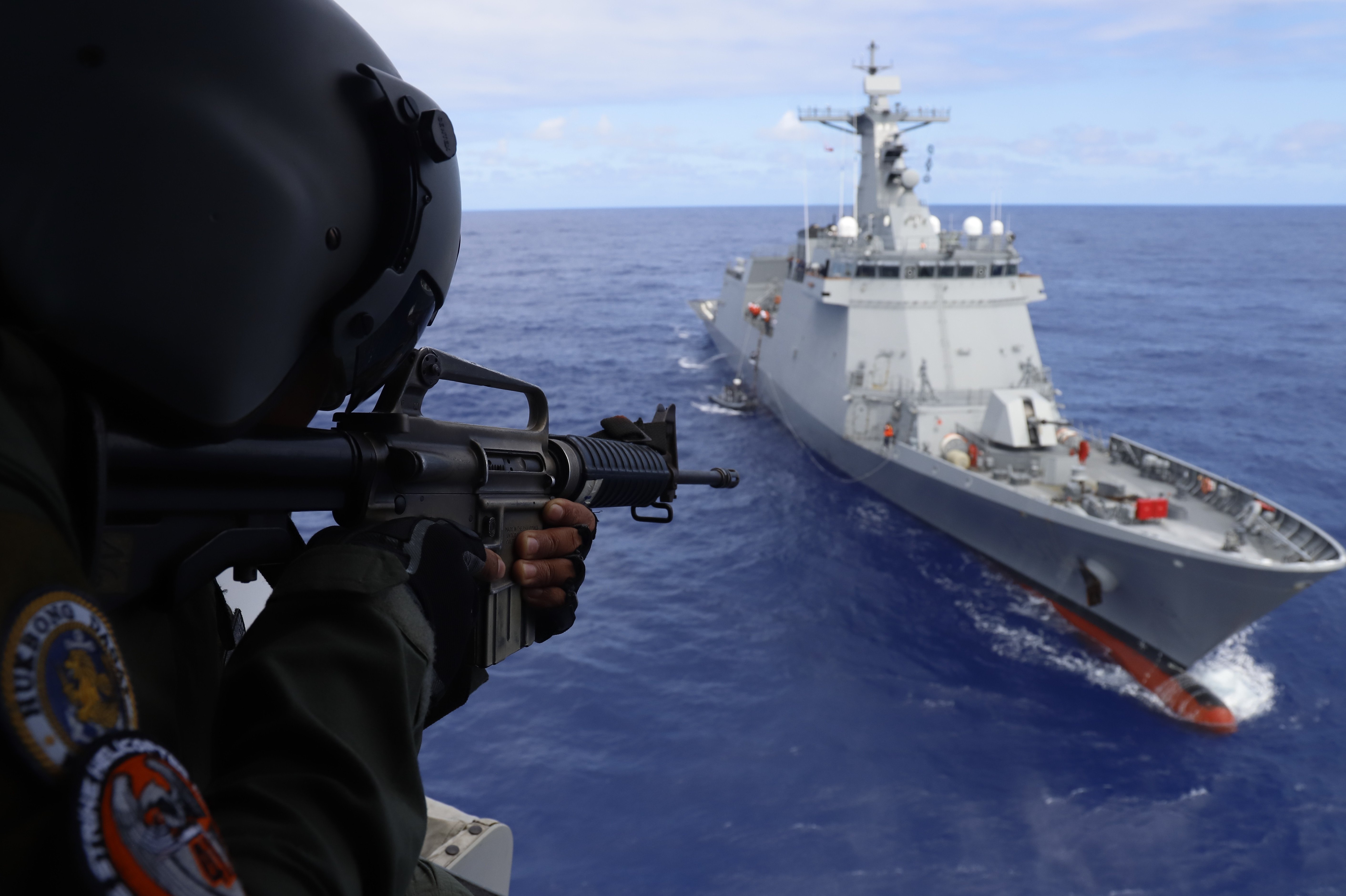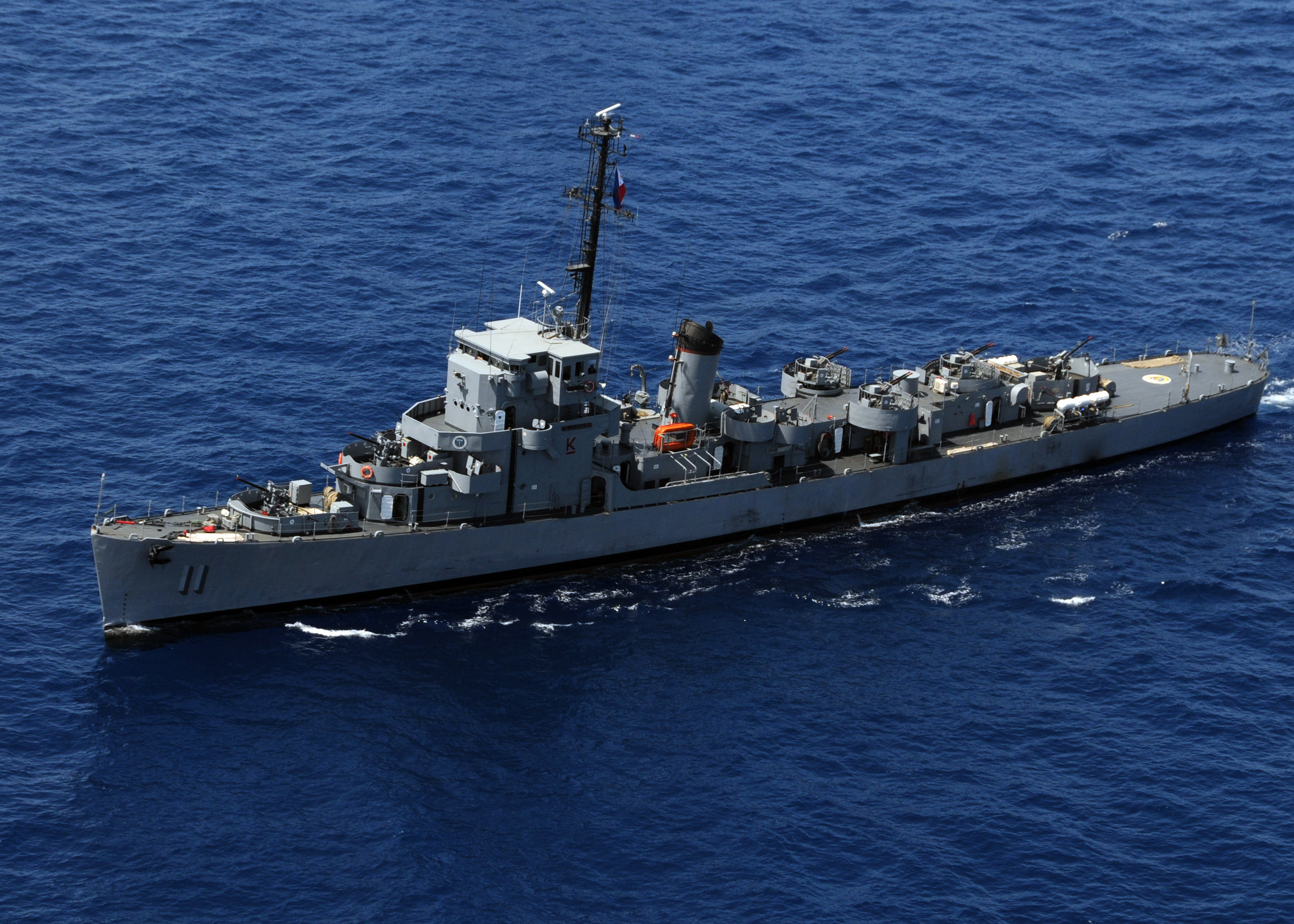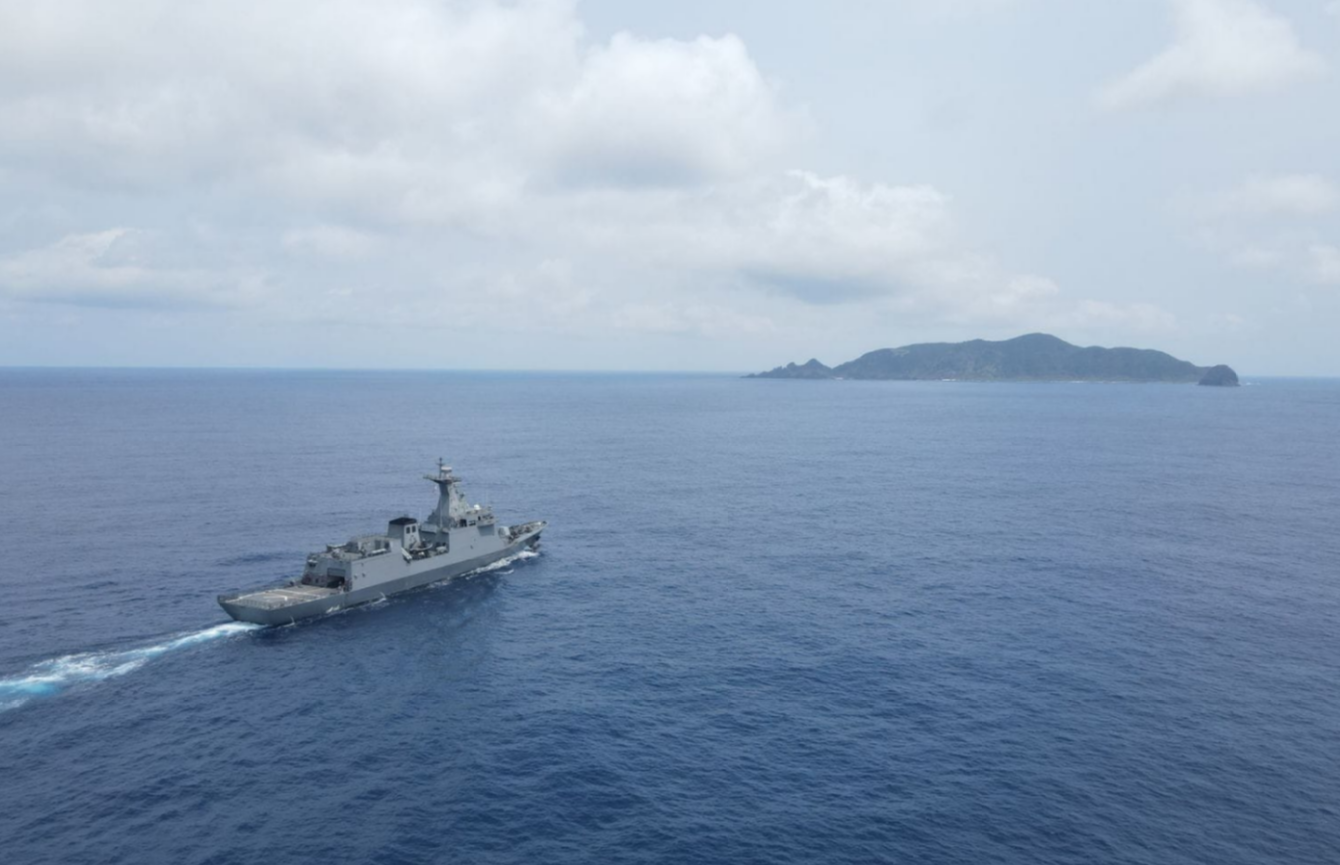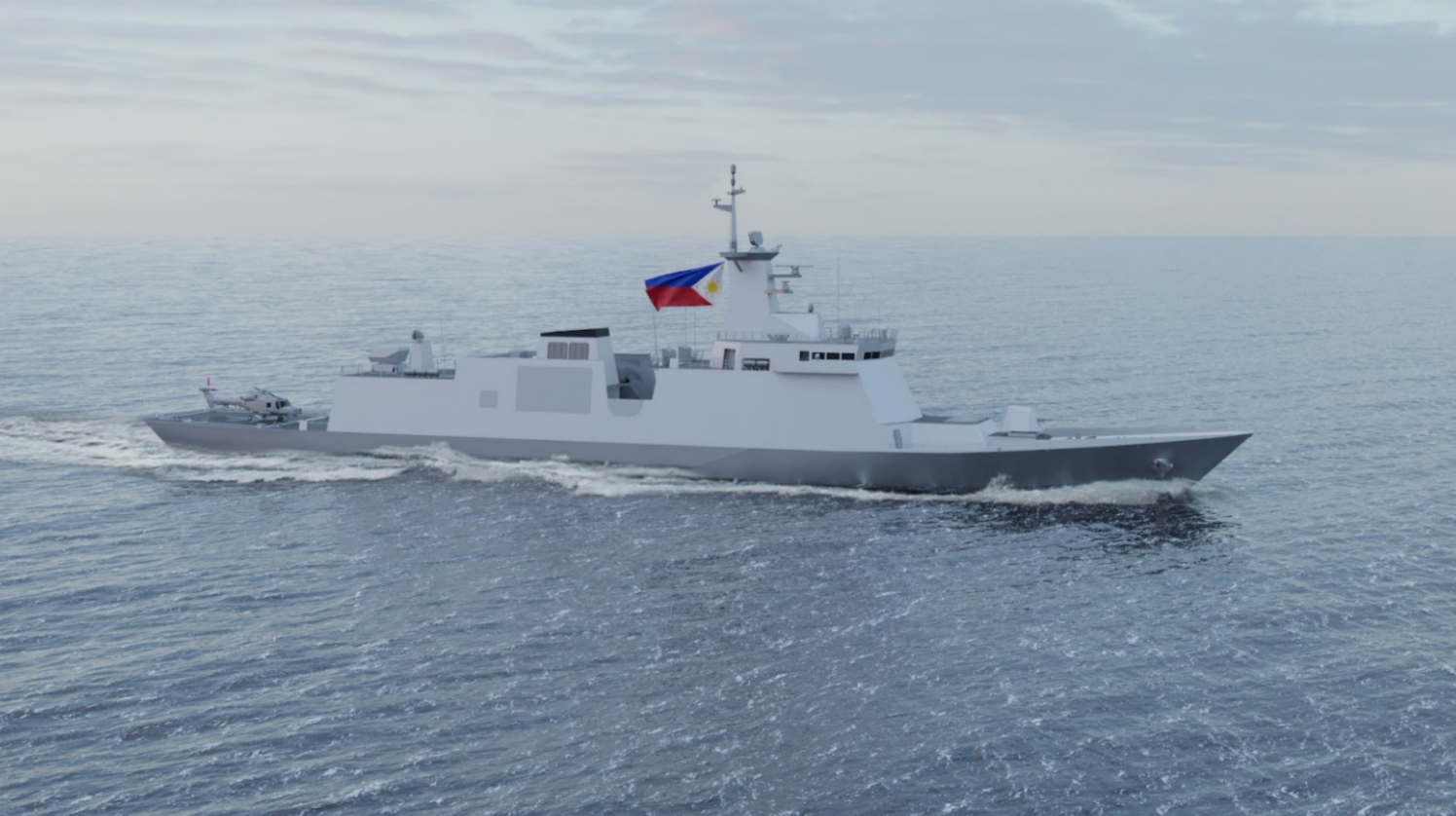Posted to US Naval Institute (USNI) News (Feb 28): Philippines Starts Latest Naval Modernization Attempt Amid South China Sea Tensions (By AARON-MATTHEW LARIOSA)

Republic of the Philippines Navy ship BRP Jose Rizal (FF-150) conducts flight operations during Exercise Rim of the Pacific (RIMPAC) 2020. AFP Photo
Amid increasing tensions in the South China Sea with China and fears of how a conflict over Taiwan could jeopardize the country’s territories in the Luzon Strait, the Philippines is looking to prioritize its naval forces in a revised military modernization plan.
Despite Manila’s encounters with China in the Philippines’ exclusive economic zone, including the construction of several military bases on artificial islands, and run-ins with Chinese vessels over the last decade, the Armed Forces of the Philippines remains underequipped, experts agree.
“The Philippine Navy has lagged behind many of its Southeast Asian peers for decades as a consequence of relative neglect as the country focused then heavily on internal security. This also resulted, most crucially, a neglect of the country’s maritime domain. Philippine maritime interests, especially in the West Philippine Sea, have been compromised,” Collin Koh, a research fellow at the Institute of Defence and Strategic Studies under the S. Rajaratnam School of International Studies in Singapore, told USNI News.
Following the 2012 Scarborough Shoal Incident, which resulted in the effective Chinese occupation of the feature within the Philippine EEZ, Manila restarted a 1990s-era modernization act previously set aside due to financial constraints. The Revised Armed Forces of the Philippines Modernization Act called for the procurement of equipment, particularly naval vessels and aircraft, to raise the AFP’s capabilities and deter further encroachment in the South China Sea.
The Philippine Navy was set to spend over $40 billion on procurements in two four-year and one five-year-long phases, known as “horizons,” between 2013 and 2028. Today, only a fraction of the spending originally planned has been executed. The armed forces failed to complete the first two horizon phases due to a lack of funds from the Philippine government and the COVID-19 Pandemic.
Amid increasing tensions in the South China Sea with China and fears of how a conflict over Taiwan could jeopardize the country’s territories in the Luzon Strait, the Philippines is looking to prioritize its naval forces in a revised military modernization plan.
Despite Manila’s encounters with China in the Philippines’ exclusive economic zone, including the construction of several military bases on artificial islands, and run-ins with Chinese vessels over the last decade, the Armed Forces of the Philippines remains underequipped, experts agree.
“The Philippine Navy has lagged behind many of its Southeast Asian peers for decades as a consequence of relative neglect as the country focused then heavily on internal security. This also resulted, most crucially, a neglect of the country’s maritime domain. Philippine maritime interests, especially in the West Philippine Sea, have been compromised,” Collin Koh, a research fellow at the Institute of Defence and Strategic Studies under the S. Rajaratnam School of International Studies in Singapore, told USNI News.
Following the 2012 Scarborough Shoal Incident, which resulted in the effective Chinese occupation of the feature within the Philippine EEZ, Manila restarted a 1990s-era modernization act previously set aside due to financial constraints. The Revised Armed Forces of the Philippines Modernization Act called for the procurement of equipment, particularly naval vessels and aircraft, to raise the AFP’s capabilities and deter further encroachment in the South China Sea.
The Philippine Navy was set to spend over $40 billion on procurements in two four-year and one five-year-long phases, known as “horizons,” between 2013 and 2028. Today, only a fraction of the spending originally planned has been executed. The armed forces failed to complete the first two horizon phases due to a lack of funds from the Philippine government and the COVID-19 Pandemic.

Republic of the Philippines Navy ship BRP Humabon (PF 11) steams in formation for a photography exercise as a part of exercise Balikatan 2010 (BK 10). US Navy Photo
The funding shortfall upended the Philippine Navy’s Strategic Sail Plan 2020. The 2012 modernization plan called for the service to procure six anti-air warfare frigates, 12 anti-submarine corvettes, 18 offshore patrol vessels, 42 missile boats and three attack submarines, as well as various amphibious and auxiliary vessels. Since then, the service has procured two frigates, three corvettes, six offshore patrol vessels and nine missile boats.
As tensions with China have risen over the last year, Manila has started to revise its plan. Following incidents at Scarborough Shoal, Second Thomas Shoal and elsewhere in the South China Sea in 2022 and 2023, the Philippines has bolstered its naval deployments to the region. Philippine lawmakers also pledged increased funding for the navy and coast guard.
“Vivid images that show Chinese ships colliding with and water-cannoning smaller Filipino boats contribute to gaining that buy-in from the voting public,” Ray Powell, director of the SeaLight project at Stanford University’s Gordian Knot Center for National Security Innovation, told USNI News.
“Manila’s assertive transparency campaign of 2023 pushed military modernization from one of many budget line items to a national imperative. This is a crucial, tangible way in which transparency contributed to Philippine national resilience against [People’s Republic of China] coercion,” he added.
In January, Philippine President Ferdinand Marcos Jr. approved a $35 billion acquisition list put forward by the Armed Forces of the Philippines for a revised version of Horizon 3 – almost equivalent to the total cost projected forby the original program. In contrast, the previous administration only approved $5.6 billion for Horizon 2.
Dubbed Re-Horizon 3, this revised phase seeks to not only obtain new equipment but also remove inefficiencies, streamlining the procurement process and developing a better defense strategy.
Secretary of National Defense Gilbert Teodoro told reporters that the Philippines has to “marshal the resources of making the best of what we have, making sure that acquisitions made are supportable [and] sustainable, and redundancy is built-in.”
“We have said that the [AFP and Department of National Defense] will not be a vendor’s paradise. We will not consider ourselves a ‘vendee’ but a client. We will demand performance from all our proponents,” Teodoro said in a Philippine Daily Inquirer article.
Teodoro blasted inefficiencies in the modernization and procurement laws, calling them “cursed.”
The funding shortfall upended the Philippine Navy’s Strategic Sail Plan 2020. The 2012 modernization plan called for the service to procure six anti-air warfare frigates, 12 anti-submarine corvettes, 18 offshore patrol vessels, 42 missile boats and three attack submarines, as well as various amphibious and auxiliary vessels. Since then, the service has procured two frigates, three corvettes, six offshore patrol vessels and nine missile boats.
As tensions with China have risen over the last year, Manila has started to revise its plan. Following incidents at Scarborough Shoal, Second Thomas Shoal and elsewhere in the South China Sea in 2022 and 2023, the Philippines has bolstered its naval deployments to the region. Philippine lawmakers also pledged increased funding for the navy and coast guard.
“Vivid images that show Chinese ships colliding with and water-cannoning smaller Filipino boats contribute to gaining that buy-in from the voting public,” Ray Powell, director of the SeaLight project at Stanford University’s Gordian Knot Center for National Security Innovation, told USNI News.
“Manila’s assertive transparency campaign of 2023 pushed military modernization from one of many budget line items to a national imperative. This is a crucial, tangible way in which transparency contributed to Philippine national resilience against [People’s Republic of China] coercion,” he added.
In January, Philippine President Ferdinand Marcos Jr. approved a $35 billion acquisition list put forward by the Armed Forces of the Philippines for a revised version of Horizon 3 – almost equivalent to the total cost projected forby the original program. In contrast, the previous administration only approved $5.6 billion for Horizon 2.
Dubbed Re-Horizon 3, this revised phase seeks to not only obtain new equipment but also remove inefficiencies, streamlining the procurement process and developing a better defense strategy.
Secretary of National Defense Gilbert Teodoro told reporters that the Philippines has to “marshal the resources of making the best of what we have, making sure that acquisitions made are supportable [and] sustainable, and redundancy is built-in.”
“We have said that the [AFP and Department of National Defense] will not be a vendor’s paradise. We will not consider ourselves a ‘vendee’ but a client. We will demand performance from all our proponents,” Teodoro said in a Philippine Daily Inquirer article.
Teodoro blasted inefficiencies in the modernization and procurement laws, calling them “cursed.”

BRP Antonio Luna (FF 151) conducts a patrol off Mavulis Island in the Luzon Strait between the Philippines and Taiwan. Philippine Navy photo
Alongside Re-Horizon 3, the new Comprehensive Archipelagic Defense Concept put forward by Philippine defense officials brings an increased emphasis on naval and air forces for the defense of the country. In this strategy, the traditionally internally focused AFP is envisioned operating offshore in the EEZ and beyond.
The Philippine Navy’s missions include patrols from the EEZ to the internal waterways of the 7,641-island country. Moreover, with an external threat from China, the force is looking to acquire high-end anti-air and submarine warfare capabilities.
Manila-based Geopolitical Analyst Don McLain Gill emphasized the need for upcoming procurements.
“The next step will be to ensure how such acquisitions can be effectively and practically integrated into the Philippines’ overarching desire to enhance its ability to secure both its internal waters and surrounding seas,” said Gill.
Koh highlighted that the country’s other maritime security organizations could “to some extent” reduce the funds the Philippine Navy needs for inland duties.
“The Philippine Coast Guard – and to a lesser extent Bureau of Fisheries and Aquatic Resources – modernization and recapitalization program can help free up the Philippine Navy to focus more on conventional warfighting and other military missions than just patrolling and enforcing the country’s EEZ,” said Koh.
Equipped with Japanese and French patrol vessels, the Philippine Coast Guard has been frequently deployed to the South China Sea to protect Philippine fishermen, ward off foreign vessels and escort Philippine Navy resupply missions to Second Thomas Shoal. The Philippine Coast Guard is set to procure a large number of ocean-going patrol ships in an upcoming modernization act.
Japan pledged to fund seven patrol ships, on top of the existing 12 previously handed over, following a diplomatic visit to Manila in November. Philippine senators have also eyed Austal’s shipyard in Cebu to build three offshore patrol vessels.
While the list of assets is not yet public, Manila has been eyeing the procurement of two to three attack submarines from either France or South Korea and more BrahMos supersonic anti-ship missiles from India for its army.
Alongside Re-Horizon 3, the new Comprehensive Archipelagic Defense Concept put forward by Philippine defense officials brings an increased emphasis on naval and air forces for the defense of the country. In this strategy, the traditionally internally focused AFP is envisioned operating offshore in the EEZ and beyond.
The Philippine Navy’s missions include patrols from the EEZ to the internal waterways of the 7,641-island country. Moreover, with an external threat from China, the force is looking to acquire high-end anti-air and submarine warfare capabilities.
Manila-based Geopolitical Analyst Don McLain Gill emphasized the need for upcoming procurements.
“The next step will be to ensure how such acquisitions can be effectively and practically integrated into the Philippines’ overarching desire to enhance its ability to secure both its internal waters and surrounding seas,” said Gill.
Koh highlighted that the country’s other maritime security organizations could “to some extent” reduce the funds the Philippine Navy needs for inland duties.
“The Philippine Coast Guard – and to a lesser extent Bureau of Fisheries and Aquatic Resources – modernization and recapitalization program can help free up the Philippine Navy to focus more on conventional warfighting and other military missions than just patrolling and enforcing the country’s EEZ,” said Koh.
Equipped with Japanese and French patrol vessels, the Philippine Coast Guard has been frequently deployed to the South China Sea to protect Philippine fishermen, ward off foreign vessels and escort Philippine Navy resupply missions to Second Thomas Shoal. The Philippine Coast Guard is set to procure a large number of ocean-going patrol ships in an upcoming modernization act.
Japan pledged to fund seven patrol ships, on top of the existing 12 previously handed over, following a diplomatic visit to Manila in November. Philippine senators have also eyed Austal’s shipyard in Cebu to build three offshore patrol vessels.
While the list of assets is not yet public, Manila has been eyeing the procurement of two to three attack submarines from either France or South Korea and more BrahMos supersonic anti-ship missiles from India for its army.

Rendering of HHI’s corvette design for the Philippine Navy. While classified as a corvette, the incoming warships will displace more and have more weaponry than the Jose Rizal-class frigates already in service. HHI Graphic
South Korea’s Hyundai Heavy Industries also expects further warships orders from the Philippine Navy. Since 2012, Manila has ordered two frigates, two corvettes and six offshore patrol vessels from the Korean shipbuilder.
Other major procurements include four landing platform docks from PT PAL Indonesia, which are the largest ships in the Philippine Navy at 7,200 tons.
Donations from the U.S. include three Hamilton-class cutters and three Cyclone patrol ships. These patrol vessels frequently patrol the South China Sea and waters around Mindanao. An additional four patrol vessels, two Protector and two Island-class patrol boats, were eyed for transfer to the Philippines pending congressional notification requirements, according to a White House press release last year.
Joshua Bernard Espeña, vice president at the Manila-based think tank International Development and Security Cooperation, told USNI News that he expected the Philippine Navy to procure more of the same offshore patrol vessels, corvettes and frigates previously procured by Manila to bolster its presence in the South China Sea.
“These relatively small but multi-role surface platforms are just what the AFP needs to put a presence in much shallow[er] EEZ waters. Especially on a tight budget, the PN needs flexible navigation for tactical and operational gains,” said Espeña.
On the other hand, Espeña views the procurement of submarines as a “symbolic acquisition” due to the conditions of the South China Sea. The attack boats would be better suited to operating in the Luzon Strait between the Philippines and Taiwan, he acknowledged.
The Philippine Navy retired its last World War II-era surface combatant in 2021 without a replacement, which reduced the overall ship count of the service. Koh emphasized that the service must view modernization through a “qualitative and quantitative lens.”
Espeña advocates for a “good enough” defense plan for Philippine forces and assigns the high-end fighting to the U.S. under the 1951 U.S.-Philippine Mutual Defense Treaty.
“Here, we leave the U.S. 7th Fleet to do the rest of a Mahanian style of warfare on the high seas. It sounds downgraded when we look at the tip of the iceberg; my hunch is that the DND seeks to optimize AFP’s Joint Operational Concept by bringing in more air defense, shore-based missile cruise missile systems, and fixed and rotary multirole wing systems, among others,” said Espeña.
South Korea’s Hyundai Heavy Industries also expects further warships orders from the Philippine Navy. Since 2012, Manila has ordered two frigates, two corvettes and six offshore patrol vessels from the Korean shipbuilder.
Other major procurements include four landing platform docks from PT PAL Indonesia, which are the largest ships in the Philippine Navy at 7,200 tons.
Donations from the U.S. include three Hamilton-class cutters and three Cyclone patrol ships. These patrol vessels frequently patrol the South China Sea and waters around Mindanao. An additional four patrol vessels, two Protector and two Island-class patrol boats, were eyed for transfer to the Philippines pending congressional notification requirements, according to a White House press release last year.
Joshua Bernard Espeña, vice president at the Manila-based think tank International Development and Security Cooperation, told USNI News that he expected the Philippine Navy to procure more of the same offshore patrol vessels, corvettes and frigates previously procured by Manila to bolster its presence in the South China Sea.
“These relatively small but multi-role surface platforms are just what the AFP needs to put a presence in much shallow[er] EEZ waters. Especially on a tight budget, the PN needs flexible navigation for tactical and operational gains,” said Espeña.
On the other hand, Espeña views the procurement of submarines as a “symbolic acquisition” due to the conditions of the South China Sea. The attack boats would be better suited to operating in the Luzon Strait between the Philippines and Taiwan, he acknowledged.
The Philippine Navy retired its last World War II-era surface combatant in 2021 without a replacement, which reduced the overall ship count of the service. Koh emphasized that the service must view modernization through a “qualitative and quantitative lens.”
Espeña advocates for a “good enough” defense plan for Philippine forces and assigns the high-end fighting to the U.S. under the 1951 U.S.-Philippine Mutual Defense Treaty.
“Here, we leave the U.S. 7th Fleet to do the rest of a Mahanian style of warfare on the high seas. It sounds downgraded when we look at the tip of the iceberg; my hunch is that the DND seeks to optimize AFP’s Joint Operational Concept by bringing in more air defense, shore-based missile cruise missile systems, and fixed and rotary multirole wing systems, among others,” said Espeña.
https://news.usni.org/2024/02/28/philippines-starts-latest-naval-modernization-attempt-amid-south-china-sea-tensions

No comments:
Post a Comment
Note: Only a member of this blog may post a comment.